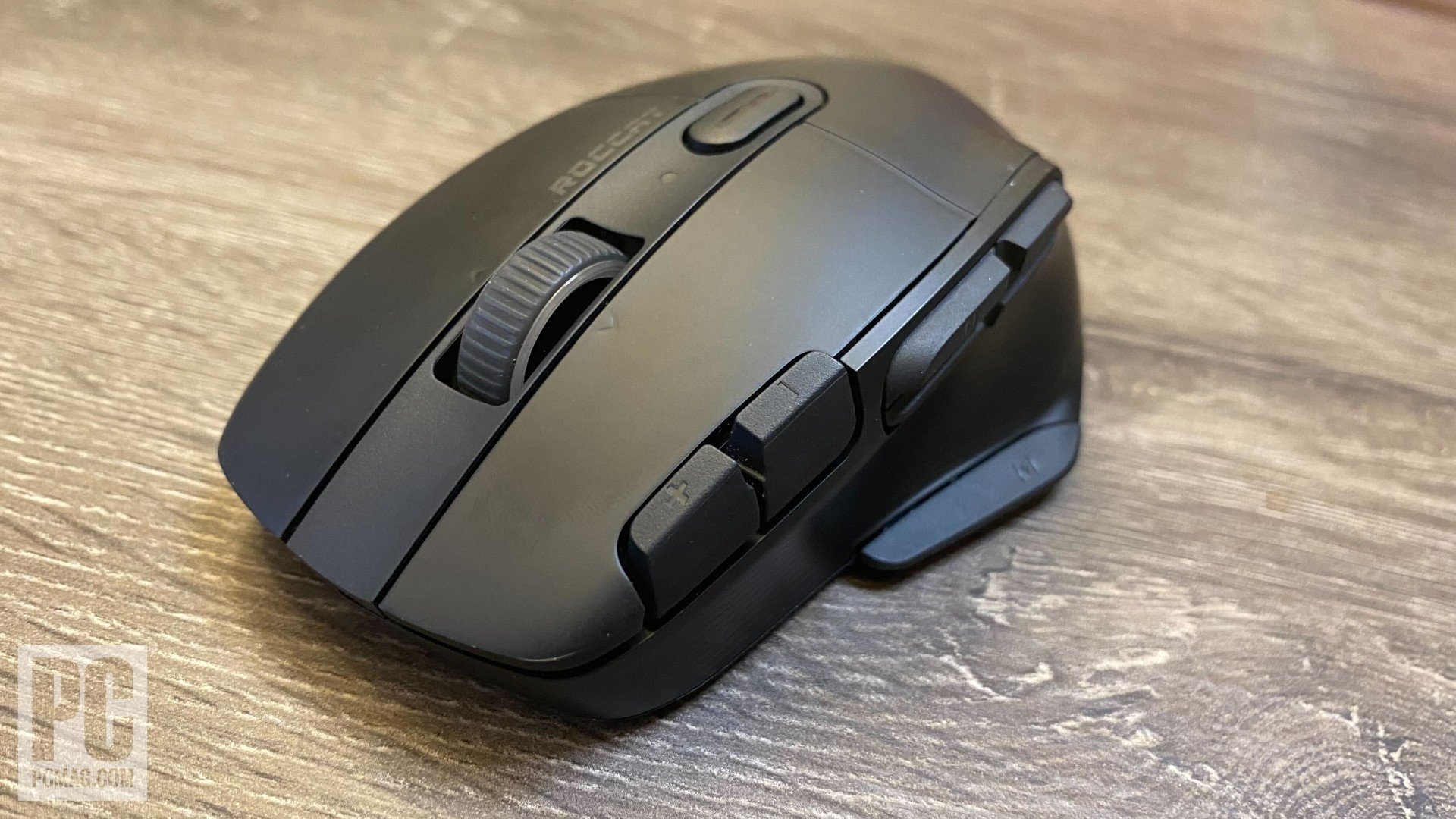Overview
- Jump To Details

Mad Catz R.A.T. 8+
Best for Gamers Who Like to Tinker - Jump To Details

Logitech MX Master 3S Wireless Mouse
Best Mouse for Big-Screen Multitaskers and Creative Pros - Jump To Details

Logitech Signature M650
Best for Productivity on a Budget - Jump To Details

Microsoft Adaptive Mouse
Best for Accessibility - Jump To Details

Roccat Kone XP
Best For Right-Handed Hardcore and Casual Gamers - Jump To Details

HyperX Pulsefire Haste Gaming Mouse
Best for Esports Competitors - Jump To Details

Razer DeathAdder V3 Pro
Best for Wireless Gaming Mouse - Jump To Details

Logitech MX Anywhere 3S
Best for On-the-Road Mousing Productivity - Jump To Details

Microsoft Surface Mobile Mouse
Best for Style-Conscious Frequent Travelers - Jump To Details

Razer Pro Click Wireless Mouse
Best for Professionals Who Want a Gaming Mouse's Features - Jump To Details

QuadraClicks RBT
Best Ergonomic Gaming Mouse - Jump To Details

Kensington Expert Mouse Wireless Trackball
Best for Ergonomic-Minded Mousers
In its most basic form, a computer mouse is simple hardware—a sensor on the bottom, two buttons and a scroll wheel on top—that lets you interact with programs as though they were extensions of your own hand. But while a mouse is simple in concept, the market for them is a scattered field of mouse genres, prices, and designs. You need to know a little about the landscape when you go shopping for a new model.
Over time, distinct classes of mice have evolved, each made for different computing situations. The most common of these is the mainstream desktop mouse, designed for use with a desktop or laptop PC at a desk or table. Aside from the inevitable right and left mouse buttons, the usual features are a clickable scroll wheel and, in some cases, additional thumb buttons that let you navigate forward and back in your web browser.
Travel mice (or "mobile mice") offer many of these same features but come in a smaller size. They're designed to fit easily into the pocket of a backpack or laptop bag. For this same reason, however, travel mice tend to be small for most hands—you can use them just fine for short stints, but they become uncomfortable over long periods due to the unnatural grip required.
Beyond these "ordinary" mice are two key mouse genres: the gaming mouse, and the ergonomic mouse. There's a lot of variance within each, and some crossover among all of these classes. (For example, a few "travel gaming" mice exist.)
Let's take a look at our favorite mice across a number of categories, including our top picks in gaming, budget, and ergonomics categories, then move on to discuss other genres and aspects that affect all mice.
You Can Trust Our Reviews
Deeper Dive: Our Top Tested Picks

Mad Catz R.A.T. 8+
Best for Gamers Who Like to TinkerBottom Line:
With a unique look and parts you can swap out for comfort, the Mad Catz R.A.T. 8+ is a high-end gaming mouse that should tickle tinkerers, as well as players seeking lots of buttons and flexibility.Pros
- Adjustable parts provide unique customization options.
- Good feel for a variety of hands.
- Unique, partly open-shell look.
Cons
- Expensive for a wired mouse.
- Adjustable features introduce small parts that are easy to misplace.
- Configuration software feels a bit lightweight.
Learn MoreMad Catz R.A.T. 8+ Review
Logitech MX Master 3S Wireless Mouse
Best Mouse for Big-Screen Multitaskers and Creative ProsBottom Line:
Silent buttons and an 8,000dpi sensor bring Logitech's flagship MX Master 3S Wireless Mouse just one or two clicks from perfection.Pros
- Remarkable comfort and battery life
- Perfectly precise electromagnetic scroll wheel
- Ultra-customizable for different apps
- Works with multiple devices and operating systems
Cons
- Lefties need not apply
- No place to store the USB dongle
- Fans of tactile clicks may prefer the older version

Logitech Signature M650
Best for Productivity on a BudgetBottom Line:
The low-priced Logitech Signature M650 is far from perfect, but it offers more than you might expect from a basic productivity mouse.Pros
- Affordable
- Two sizes and a left-handed version available
- Bluetooth and 2.4GHz connection options
- Remarkable battery life
Cons
- Narrow shape
- Limited features and functionality
- Standard size is too small
- Relies on AA battery
Learn MoreLogitech Signature M650 Review
Microsoft Adaptive Mouse
Best for AccessibilityBottom Line:
For those who may need it, the Microsoft Adaptive Mouse is a highly noteworthy achievement in accessibility and productivity for computer mice, particularly when paired with Microsoft's Adaptive Hub and its accessories.Pros
- Inclusive design philosophy
- Highly compact
- Ambidextrous body design
- Can be augmented by many 3D-printed accessories
Cons
- Needs accessories to work as intended
- 3D printed accessories are pricey
- Microsoft Accessory Center is Windows-exclusive
Get It NowLearn MoreMicrosoft Adaptive Mouse Review
Roccat Kone XP
Best For Right-Handed Hardcore and Casual GamersBottom Line:
Roccat nearly perfects its AIMO line with the Kone XP, a gaming mouse with a cornucopia of top-shelf components and features.Pros
- Generous complement of 15 buttons
- Nvidia Reflex support
- Gorgeous RGB lighting
- Premium switches
- Good price for the features
Cons
- Not for left-handed users
- Slightly bulky shell
- Swarm app could use a bit of modernizing
Learn MoreRoccat Kone XP Review
HyperX Pulsefire Haste Gaming Mouse
Best for Esports CompetitorsBottom Line:
Lightweight, comfortable, and reasonably priced, the HyperX Pulsefire Haste is the best esports mouse to come along in some time.Pros
- Extremely light
- Terrific sensor for the price
- Onboard memory
- Stylish honeycomb chassis
Cons
- Chassis shape could use a bit more support
- Little RGB lighting

Razer DeathAdder V3 Pro
Best for Wireless Gaming MouseBottom Line:
The Razer DeathAdder V3 Pro delivers a bevy of improvements to Razer's long running gaming-mouse line that, while not essential, help solidify its spot at the top of the food chain.Pros
- Enhanced ergonomic design
- Tons of improvements
- True 4,000Hz polling rate (with Hyperpolling dongle)
- Lightweight
Cons
- Expensive
- Improvements aren't really game-changers
- Hyperpolling wireless dongle sold separately
Learn MoreRazer DeathAdder V3 Pro Review
Logitech MX Anywhere 3S
Best for On-the-Road Mousing ProductivityBottom Line:
Logitech's MX Anywhere 3S doesn't reinvent the wheel (or any other part), but it improves upon the Anywhere 3 in ways that are sure to impress those in the market for a travel-ready wireless mouse.Pros
- Sleek, comfortable design
- Powerful customization software
- Quiet clicks
- Improved sensor
- Long battery life
Cons
- May be small for larger hands
- Too few changes to warrant an upgrade
Learn MoreLogitech MX Anywhere 3S Review
Microsoft Surface Mobile Mouse
Best for Style-Conscious Frequent TravelersBottom Line:
The Microsoft Surface Mobile Mouse is a well-engineered peripheral with long battery life, a stylish design, and cutting-edge wireless connectivity.Pros
- Comfortable, space-saving design
- Sturdy build quality
- Multiple color options
- Easy setup
- Supports Windows Swift Pair
- Long rated battery life
- Affordable
Cons
- Occasional connection lag
- Limited palm support
Learn MoreMicrosoft Surface Mobile Mouse Review
Razer Pro Click Wireless Mouse
Best for Professionals Who Want a Gaming Mouse's FeaturesBottom Line:
The Razer Pro Click tweaks the company’s best gaming mouse design to make an essential office mouse for power-users.Pros
- Strong ergonomic shape
- Supports Bluetooth and 2.4 GHz wireless
- Multi-device syncing
- Eight buttons, including wheel tilt inputs
- Built-in wireless dongle storage
- Very strong battery life
Cons
- Micro-USB charging port
Learn MoreRazer Pro Click Wireless Mouse Review
QuadraClicks RBT
Best Ergonomic Gaming MouseBottom Line:
The QuadraClicks RBT, a rare ergonomic mouse built for gaming, is a pricey-but-promising tool for reducing wear and tear on your most important weapon: your hands.Pros
- Innovative, comfortable design
- Fast, responsive sensor
- Unique ergonomics
- Can be reimbursed by some health insurance plans
Cons
- Expensive
- Software is Windows-only
- Takes some getting used to
Learn MoreQuadraClicks RBT Review
Kensington Expert Mouse Wireless Trackball
Best for Ergonomic-Minded MousersBottom Line:
Wrist need a rest? The Kensington Expert Mouse Wireless Trackball has everything you need to make the fingers-only trackball experience your own.Pros
- Comfortable design, including game-changing scrolling ring
- Bluetooth and 2.4GHz wireless
- Detachable wrist rest
- Lots of customization available via config software
Cons
- Relies on disposable batteries (may be a pro to some)
- Noisy click panels
Buying Guide: The Best Computer Mice for 2024
What's the Best Gaming Mouse?
Gaming mice amplify every element of the basic mouse concept to the extreme: more buttons, higher tracking resolutions, curvier curves. Some gaming mice are general gaming models, while others are designed for specific game genres. In the latter case, depending upon the style of the game that the mouse is intended for (first-person shooter, real-time strategy game, MMO), you may see a variety of specialized features.
What most gaming mice have in common, though, is a combination of high-performance parts—laser sensors, feather-light click buttons, gold-plated USB connectors—and customization features, such as programmable macro commands and on-the-fly resolution switching. Gaming mice also stand apart in that the better ones tend to feature vendor-supplied software for setting up these custom features and shortcuts, defined sometimes on a per-game basis via profiles. The software's quality and functionality can vary wildly from vendor to vendor; that's where our reviews come in. Certain utilities are easier to pick up than others.
 (Credit: HyperX)
(Credit: HyperX)For maximum comfort, some gaming mice let you customize the body of the mouse itself. Removable weights are common, letting you tweak the total heft of the mouse one way or the other. Some models take this even further, letting you shift the center of balance, or adjust the height and pitch of the palm rest. For non-gamers, these features are overkill; for dedicated gamers, they provide a competitive edge.
Finding the ideal gaming mouse for you comes down to knowing your preferred style of game, determining whether or not you will take advantage of any of a mouse's more complex functions (it's easy to overspend on a gaming mouse), and then tweaking your choice to your specific tastes. Drive by our gaming mouse roundup for much more detail on the nuances of these mice.
What's the Best Ergonomic Mouse?
Ergonomics-first designs put all of the typical mouse functions into a form factor that places your hand in a neutral position. Designed to reduce the stresses that can lead to carpal tunnel and repetitive strain injury, ergonomic mice may look unusual and take some getting used to, but they do alleviate some very real problems. Some have a vertical design; others may have one-off sculpts.
 (Credit: Mike Epstein)
(Credit: Mike Epstein)Whether you're looking at a specialized ergonomic mouse, or comfort is simply a concern in a more ordinary one, pay attention to the size of your mouse. (Make sure that it's not too big or too small for your hand.) Weight is also a consideration. Some people prefer a heavier mouse that anchors the hand, while others, especially players of MOBA games, want something light that furnishes little resistance to flicking and clicking. As a rule of thumb, a heavier mouse requires more effort to move, and even though the difference may not seem like much, over time it can mount.
It's not just weight and size that are important. The sculpting of the mouse can also lead to unnecessary strain on (or conversely, extra support for) your hand and wrist. The most comfortable mice will fit the contour of your hand, rather than having a flat, shallow shape. Some mice have a thumb rest, providing a resting spot from which the finger can rise as needed to activate controls. (See our guide to the best ergonomic mice for more about the nuances of these very variable mice, in addition to a discussion of trackballs.)
Not Just USB: Mouse Connectivity
The simplest way to hook up a mouse to your PC is through a wired USB connection. Computer mice are usually plug-and-play devices, with no additional software to install (with the exception of higher-end gaming mice), meaning that plugging in the cable is all the setup you'll need to deal with. Unlike wireless alternatives, a wired device will draw its power over USB, so there are no batteries to worry about. Wired connections are also preferable for serious gaming or esports use (no battery to conk out in the midst of a match), though some high-end wireless mice are indistinguishable, from a response-time perspective, from wired ones.
If you want more freedom and less cable clutter on your desk, however, it's hard to beat a wireless mouse. Instead of a wired connection, wireless mice transmit data to your PC through one of two primary means: an RF connection to a USB receiver, or via Bluetooth. (Some mice actually support both, but this is less common than supporting just one.) Both have their pros and cons, but if you want to reduce the number of cables on your desk and gain the flexibility to use your mouse unhindered—or even from across the room—wireless is the way to go.
 (Credit: Zackery Cuevas)
(Credit: Zackery Cuevas)Most wireless mice connect to the host computer via the same 2.4GHz wireless frequency used by cordless phones and some Wi-Fi Internet bands. A dime-size USB dongle—small enough to plug in and forget about—provides the link to your PC. Know, however, that only in some isolated cases (such as with Logitech's Unifying-branded gear) can a single USB dongle provide connectivity to more than one device. That means that unless the vendor specifically notes otherwise, you can't use the same adapter for your wireless mouse and keyboard. You may need to devote two USB ports to separate mouse and keyboard USB dongles.
Bluetooth options, in contrast, don't monopolize a USB port, and the stable, easy-to-manage connections are ideal for use with mobile devices, such as ultraportables, tablet PCs, and 2-in-1s. In regular use, a Bluetooth connection gives you roughly 30 feet of wireless range, but a Bluetooth mouse may not match the battery life offered by devices with an RF-based USB dongle. New innovations, such as motion sensors tied to power and connection management, can improve the battery life versus older Bluetooth devices, which maintained an always-on link that drained battery relatively quickly. But you'll want to look at the vendors' estimated battery life on a charge (as well as whether the mouse uses an internal battery you recharge, or disposables).
Understanding Mouse Sensors and Sensitivity Specs
Most of today's mice use one of two types of light-based motion sensor: optical/LED, or laser. Unlike mechanical tracking options of yore, light-based sensors have fewer issues with dust and dirt, and the absence of moving parts means fewer failures.
Optical sensors pair a glowing LED beam—often red, blue, or infrared—with a small photo sensor, tracking movement by repeatedly imaging the surface below the mouse, translating any movement of the mouse into cursor movement. (The frequency of this imaging is called the "polling rate," expressed as hertz, or hundreds of instances per second.) Because of the imaging sensor used, optical mice are a little less prone to problems caused by lifting the mouse when in use or by mousing on an uneven surface.
 (Credit: Mike Epstein)
(Credit: Mike Epstein)Laser mice operate in a similar way, but they use an infrared laser diode instead of an LED. This allows, in some cases, for greater potential sensitivity (measured in dots per inch, or dpi) and polling rates. The one drawback is that they can be finicky about the surfaces on which they are used. Premium gaming mice generally use laser sensors, and they tend to work better with opaque mouse-pad surfaces meant for mousing; LEDs can be more forgiving. But this is not an absolute, and frankly, if you're concerned at all about mousing precision, a basic mouse pad will solve all ails.
To offer the higher sensitivity of a laser sensor and the versatility of an optical mouse, a few isolated mice use both in tandem. Most better gaming mice also offer sensitivity adjustment, letting you shift from a precision setting for tight cursor-control circumstances (such as lining up a sniper's shot) to a broader-sweep one for melee combat and run-and-gun situations, or panning across an RTS world. This may be via dedicated-purpose button, or you may be able to program one of the mouse's buttons or toggles to execute resolution/sensitivity changes on the fly.
So, Which Mouse Should I Buy?
Below is a rundown of the current top-rated computer mice we've run across in our testing. (Click through to read the full reviews.) We've tested a wide array of models across the categories of gaming, productivity, and specialized ergonomic mice.











